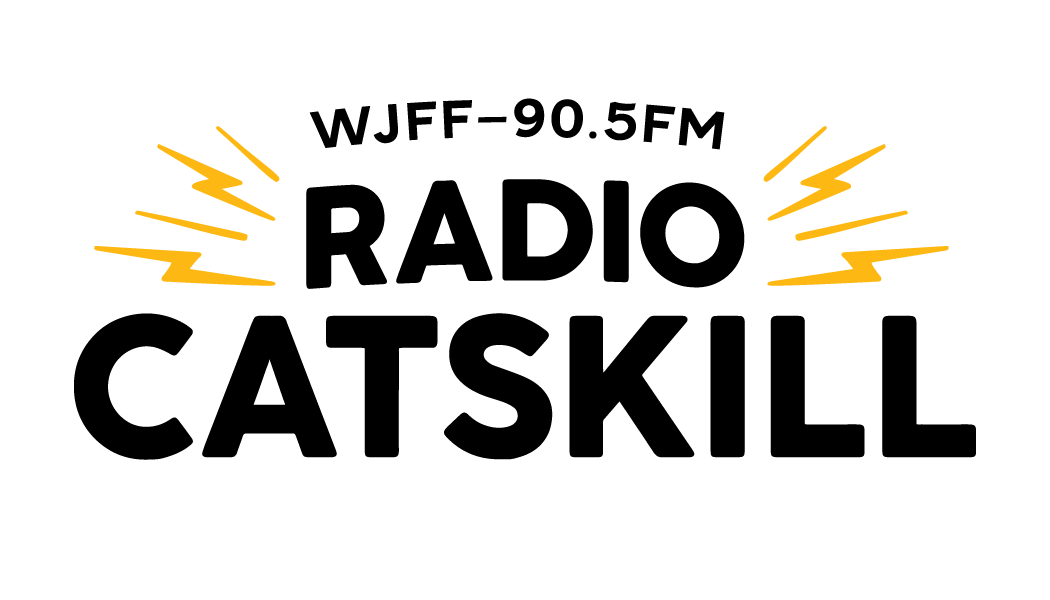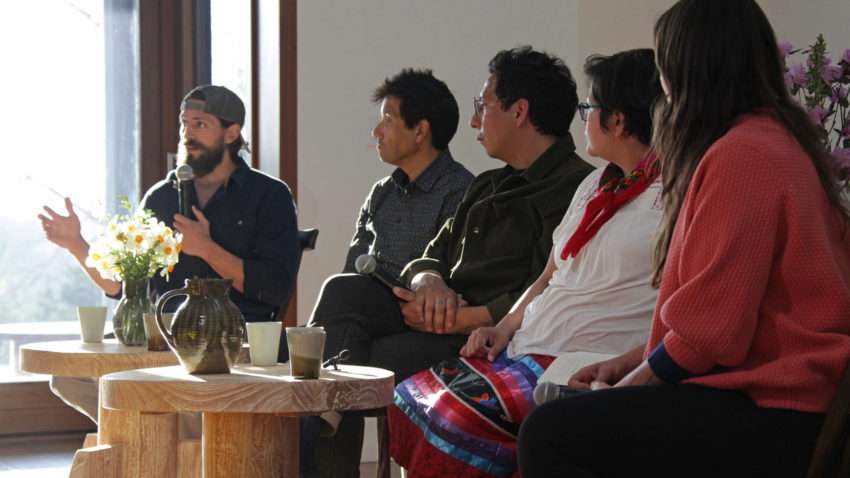The Hudson Valley is no stranger to the arts. Think of Thomas Cole’s monumental paintings that came out of the Hudson River School of the mid-19th-century — romantic depictions of the serene river lined with pine trees or cascading shots of the Catskills Mountains the region is famous for. But what these historical paintings noticeably lack are people — specifically its original inhabitants.
Forge Project, an Indigenous-led non-profit located on the unceded land of the Moh-He-Con-Nuck Community in Columbia County, has been working to interrogate that artistic history. Co-founded in 2021 by Becky Gochman and Zach Feuer, they aim to elevate contemporary Indigenous artists and cultural practitioners and expand their leadership within these domains. Forge is led by an Indigenous Steering Council composed of seven Indigenous leaders and work in relationship to the nearby Stockbridge-Munsee Community in Wisconsin, where many members are descended from the Mohican who inhabited upstate New York before they were forcibly displaced by settlers.
Sarah Biscarra Dilley is Forge’s Director of Indigenous Programs & Relationality and an Indigenous multidisciplinary artist from the yak titʸu titʸu yak tiłhini Northern Chumash tribe. After introducing themselves in tɨnɨsmuʔ tiłhinktitʸu, their native Northern Chumash language, in an interview with Radio Catskill, Dilley explained that the non-profit’s focus on supporting contemporary Indigenous artists and cultivating relationships between them through their programming is about affirming their existence in the face of the legacies of settler colonialism. This includes not only the physical removal of Indigenous tribes from the Hudson Valley region but also the narrative erasure of Indigenous communities from this land throughout history.
“One of the things that we can say [about] the distinct history of the Hudson River painters here… is that this is their cultural practice of imagining, imagining a world that is present for their exploitation,” Dilley said “So by absenting people, by absenting Indigenous communities from those images, they’re also reading into this narrative that is kind of initiated through the Doctrine of Discovery and the papal bulls that are happening in the 1490s…And so those images to me are more of a case study on settler colonialism than they are a representation of Indigenous worlds because this is what they imagine.”
Forge hosts multiple projects, including an annual artist fellowship program where six artists — two of whom are guaranteed to be from the Stockbridge-Munsee Community — are given $25,000 and access to the non-profit’s onsite resources. The project also hosts an art criticism residency program, referred to as “Confluence,” and oversees their own lending collection of contemporary Indigenous art.
Candice Hopkins, Forge’s Executive Director and Chief Curator and a citizen of the Carcross/Tagish First Nation in Canada, said they’ve been able to support more than 300 Indigenous cultural workers as a result of these different programs. Their lending collection of 180 works specifically has expanded to be one of the leading collections of its kind in the United States, Hopkins said. Entering Forge’s main residence, visitors are likely to encounter some of the works on display — such as artist Nicholas Galanin’s (Tlingit/Unangax̂) large-scale installation Never Forget (2021), wherein 45-foot letters spelling “Indian Land,” in reference to the Hollywood sign, are photographed as they loom outside of the art festival Desert X in Palm Springs.
“I feel like what we can do as an organization ultimately is to change the narrative,” Hopkins said. “Our lending collection of contemporary native art, we use that not only to build knowledge about the incredible artists who’ve been making this work since time immemorial, but we use it to put pressure. We ask questions like — Why was the last group exhibition of native art at the [MOMA] in 1942? Why hasn’t there been one since? Why was the only solo exhibition in 2020? Why have these major collections of contemporary American art really ignored the work of native artists?”
This comes as the art world has increasingly faced criticism in the last few decades for its stealing of Indigenous cultural objects to fill the inventories of museums like the American Museum of Natural History. Although the Native American Graves Protection and Repatriation Act (NAGPRA) was passed in 1990 to address the right of Indigenous communities to have museums and federal agencies return stolen human remains and sacred objects, the process of repatriation has often been a painful one, Dilley, who had served on the University of California’s NAGPRA Oversight and Implementation Committee, said. Furthermore, Dilley said the institutional exclusion of Indigenous voices has contributed to not only this issue but also the whitewashing of Indigenous artistic traditions.
“I was really privileged to have started my undergrad at the Institute of American Indian Arts, which is the only tribal arts school in the United States,” Dilley said. “I really credit it with offering this kind of foundation where our art historical canon is taught at the center. It gave me that fire that I needed to be able to write from that place of directness where I’m like, I don’t have any question about whether or not our contributions and the ways that our practices have been absolutely influential to Capital A art. Indigenous people invented abstraction, and I’m talking about globally. There are so many movements in art history that are directly connected to the contributions of indigenous people all over the world, and those contributions have been erased.”
But in their desire to disrupt, rather than reproduce, the harm institutions have long enacted against Indigenous communities, Forge has had to critically look inwards as well. They recently shifted from a private organization to a non-profit led by the Indigenous Steering Council, with the intent of modeling traditional forms of collective governance. In addition, they established a working partnership with the Stockbridge-Munsee Community, whose ancestral lands they occupy, through a memorandum of understanding (MOU) that is the product of collaboration between Dilley and Monique Tyndall, Director Of Cultural Affairs.
“Instead of coming to them with a preconceived idea of how we were gonna work together, which is often what organizations are doing, we spent the better part of a year co-writing a memorandum of understanding, and that was done really with that diplomatic intent,” Dilley said. “It was also done collaboratively so we could map out commitments and deliverables that actually made the most sense for the community. But when we had the completed MOU, it was looked over by the tribe’s lawyers, and it was voted in by their tribal council. So we’re really trying to recognize the sovereignty of their government through how we’re working with them.”
Hopkins said it also means that they do not take the land they are located on lightly. In addition to their work within the art realm, the non-profit is also engaged in land remediation and research efforts. They’ve reintroduced native species in the meadow that sits below their two residences, as well as developed a cultural easement agreement with the Stockbridge-Munsee Community that guarantees their cultural access to and stewardship of the land.
“The health of the land will be our legacy,” Hopkins said. “Hudson Valley now is a place of a lot of introduced species of plants. It’s also witness to a kind of world outta balance. That’s why we have such a bad tick epidemic — climate change shifts our ecosystems quite radically. So one of the first things that we did was engage with Misty Cook, who’s a plant knowledge holder from Stockbridge-Munsee Community. She did a plant analysis for us, and then we started engaging with other allies and knowledge holders. We worked with them to welcome back native seeds to the land.”
Culture, Hopkins argue, is what builds our society. While it has been the site of perpetuating Indigenous erasure, she said Forge is based on the understanding that it also contains the same potential to disrupt this legacy and envision a new world.
“My belief is that culture is a signifier of the health of any society,” Hopkins said. “Culture broadly means not just visual art, doesn’t just mean song, doesn’t mean music. It means all of those things together. It means dance, it means storytelling. It means theater. It means all of those things. It means the ability to work in your own languages. All of those contribute to a healthy society. And so much of the history of settler colonialism has been about not only legally and violently removing those things from our cultures, as made people through boarding schools, through displacement, through both direct and attempted genocide, removal. That’s why we focus on cultural leaders broadly…because they’re all part of this investment in creating healthier futures.
Image: Forge Project Fellows speaking alongside Executive Director Candice Hopkins in 2021, the year the non-profit was established. (Photo credit: forgeproject.com)
Note: This story was updated on July 17 to include that Forge Project was established by co-founders Becky Gochman and Zach Feuer.

